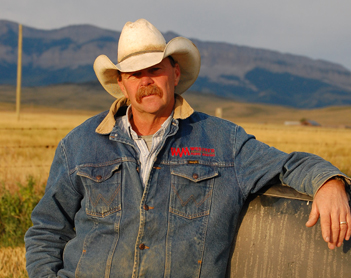
Made-in-Montana

The process to ensure there is a place for everyone on the public lands of the Rocky Mountain Front has taken five years. Since it was first hatched in 2007 to it's introduction in Congress in 2011, the Heritage Act has undergone dozens of substantive changes and modifications. These changes are a direct outcome of ongoing collaboration including eight public meetings, countless kitchen table discussions and small group meetings with local permitted users, elected officials, and landowners.
2007 - The year we began exploring ways to protect the character of the public lands on the Rocky Mountain Front and ensure everyone had a place on the land. Along the way we talked with land managers, landowners, livestock operators, and elected officials to get their initial ideas on how best to do it.
 |
|
“My family has been ranching here for 128 years and the Act will help protect the Front’s wild lands and working landscapes for generations to come.” –Karl Rappold, Dupuyer Rancher |
- Rocky Mountain Front Birch Creek South Travel Plan (started in 2000) is approved and no legal challenges are filed. The plan upholds traditional uses and spurs Coalition members to pursue legislation which would provide a more permanent way to protect the character of the public lands on the Rocky Mountain Front.
- The Coalition hosts multiple gatherings of local citizens to encourage discussions and meets with land managers, landowners, livestock operators, and elected officials to explore new possibilities.
- A new custom-tailored land designation, called the Conservation Management Area, is proposed.
- Rocky Mountain Front Weed Roundtable, wildlife biologists, and livestock producers identify noxious weeds as a common enemy on the Front.
2008 - A busy year where we expanded the circle of participants to include other ranchers, all grazing permittees on the relevant USFS and BLM lands, local businesses and county commissioners from Glacier, Pondera, Teton, and Lewis and Clark Counties.
- The earliest version of draft legislation including proposals for noxious weeds, customized designations and boundaries are crafted.
- Earliest versions of draft legislation and outreach maps are discussed and modified based on conversations with ranchers, grazing permittees, USFS and BLM land managers, local businesses and county commissioners from Glacier, Pondera, Teton, and Lewis and Clark Counties.
2009 - After working out the details locally we were ready to take the proposal on the road and held four well-publicized, public discussions. On the heels of the public discussions we had follow-up meetings with key stakeholders and we subsequently modified the proposal based on what we heard.
- Coalition shares proposed legislation and solicits feedback from public by posting to website and holding four well-publicized, public discussions in Great Falls, Helena, Choteau, and Augusta.
- The Coalition holds multiple follow-up meetings with ranchers, country commissioners, hunting and angling groups, the Forest Service and landowners.
- Based on feedback from public meetings and follow-up meetings, the plan undergoes a significant round of revisions.
2010 - The outreach with Montanans continues as we seek more feedback and important endorsements for the plan.
- Coalition continues outreach and open dialogues with many groups and individuals including Montana’s congressional delegation, the Montana Mountain Bike Association, the Alliance for the Wild Rockies, and local County Commissioners.
- Two letters of support are sent to MT delegation – one letter signed by three former Chiefs of the Forest Service and the other by retired top Montana wildlife professionals.
- Montana Association of Counties consulted regarding the potential economic impact of the Heritage Act. It is determined that the Heritage Act will not reduce the county tax base.
- The Coalition hosts multiple meetings with outfitting operations, Forest Service personnel, and families with grazing permits within Heritage Act boundaries.
2011 - The Heritage Act was again modified to reflect ongoing discussions with members of the Lincoln community and another four public meetings are held.
- Coalition meets with citizens from Lincoln to discuss the inclusion of the portions of the Lincoln Ranger District in the Heritage Act. Based upon feedback from the community, these areas are dropped.
- Coalition works with the weed boards and local county commissioners to submit a fiscal year 2012 federal appropriation request to combat noxious weeds.
- Coalition invites Senator Max Baucus to attend public meetings and hosts four in communities surrounding the Front.
- Max Baucus sponsors Front Heritage Act and makes additional revisions based on listening to input at public meetings.
2012 - The Heritage Act recieved a hearing in Washington DC and an additional listening session in Choteau, MT.
- The Heritage Act has a hearing in the Senate in front of the Energy and Natural Resources Committee. Rancher Dusty Crary testifies on behalf of the bill. There was no opposing witness and Senator Baucus spoke eloquently in support of the bill.
- At their annual convention in Billings, Montana Back Country Horsemen honor Senator Baucus for introducing the RMFHA. The event was very successful.
- Former Congressman Rehberg convenes a public meeting in Choteau on the RMFHA. More than two hundred people attended and around 60 people spoke with more than 2:1 in favor of the bill. There was a very diverse crowd and lots of locals (tribal, rancher, farmer, and outfitter) spoke in support of the Heritage Act.
- The Coalition donated $23,000 for on-the-ground noxious weed work along the Front.
2013 - Heritage Act is reintroduced in the 113th Congress with some modifications based on feedback from the public
- Senator Baucus reintroduces the Rocky Mountain Front Heritage Act on the 100th Anniversary of the Sun River Game Preserve to honor the legacy of Montanans working together.
- Provisions are strengthened for grazing rights within the Conservation Management Area.
- Provisions are strengthened to ensure the Benchmark Landing Strip is still available for public use by pilots.
Montanans can continue to engage and comment on the legislation on the website of Senator Max Baucus.


